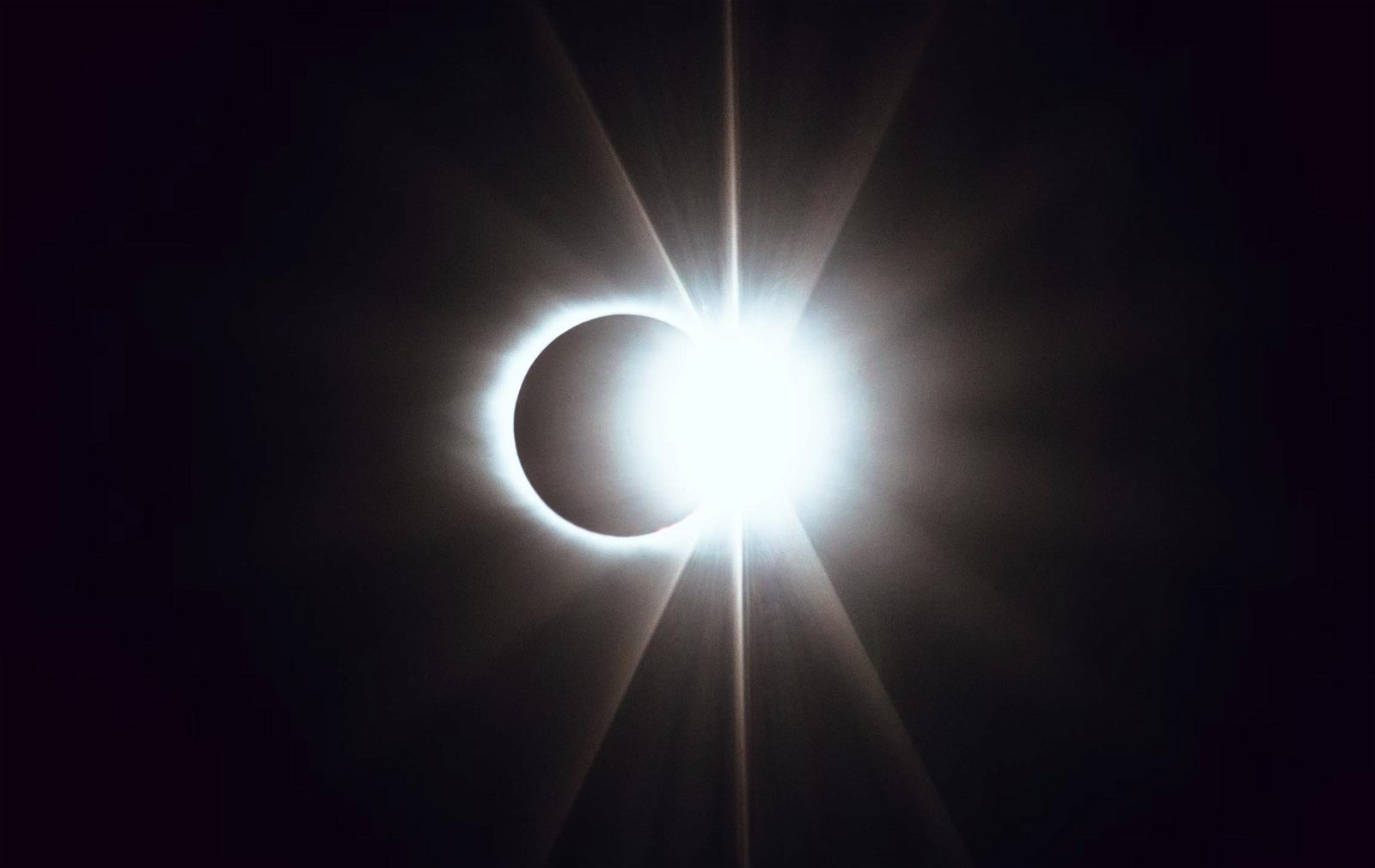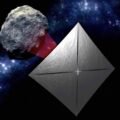The Moon is receding from Earth at a speed of 3.8 centimeters per year, which equals its distance of 38 billion centimeters per ten billion years. Ten billion years is roughly twice the age of the Solar system and comparable to the age of the Universe.
By coincidence, the mean angular diameter of the Moon, 0.515 degrees, is nearly identical to the mean angular diameter of the Sun, 0.533 degrees. From our vantage point on Earth, this allows us to witness a full eclipse of the Sun by the Moon. But as the Moon is receding, its angular size will shrink and become significantly smaller than that of the Sun within hundreds of millions of years. Altogether, there are two coincidences at play here: the near equality of the lunar and solar sizes in our sky and the fact that we live on Earth while this coincidence is happening.
But there is more to make us feel lucky. The mean density of the Sun is 1.41 grams per cubic centimeter, comparable to the mean density of the Moon – 3.34 grams per cubic centimeter. Again, this a pure coincidence because the Moon is a cold solid rock whereas the Sun is mostly made of a hot hydrogen gas.
The tidal acceleration that an external body exerts on Earth is proportional to its mass divided by the cube of its distance. The body’s mass scales as the body’s mean density times the cube of the body’s diameter. Hence, the tidal acceleration on Earth scales as the body’s mean density times the cube of the ratio between the body’s diameter and distance. The diameter-to-distance ratio is the angular size of the body when viewed from Earth.
Since the Moon and the Sun have roughly the same mean densities and angular diameters in our sky, they also exert similar tidal accelerations on Earth. This constitutes a fourth coincidence. The Moon’s tidal acceleration is nearly ten million times smaller than the Earth’s surface gravity of 9.8 meters per second squared, whereas the Sun’s tide is about half of the Moon’s tide.
For future residents of the Moon, the Earth would appear to occupy 1.5-2 degrees in their sky, about 3-4 times larger than the Moon appears from Earth. The mean density of Earth is 5.51 grams per cubic centimeter, about 4 times bigger than that of the Sun. As a result, the tidal acceleration of the Earth on the lunar surface is more than an order of magnitude larger than that of the Sun. It amounts to about a part in ten thousand of the lunar surface gravity of 1.62 meters per second squared.
For future residents of Mars, the moons Phobos and Deimos occupy angular diameters of 0.2 and 0.02 degrees. Their mean densities are 1.88 and 1.47 grams per cubic centimeter so Deimos’ tidal effect on Mars is negligible compared to that of Phobos. Mars is 1.52 times farther from the Sun than the Earth is, implying that the Sun occupies an angular diameter of 0.35 degrees from the Martian surface.
Altogether, the tidal acceleration from the Sun is about 4 times bigger than that of Phobos on the Martian surface. It measures up to a fraction of about a part in 12 million of the Martian surface gravity, which is 3.71 meters per second squared or 38% of the Earth’s surface gravity. If humans ever terraform Mars and return oceans to its surface, these tidal effects would be part of their lives. The solar tide would be periodic on a timescale of 1.88 years, whereas Phobos’ tide would repeat at a quarter of the solar amplitude every 7 hours and 39 minutes. The factor of 4 in the tidal coincidence between Phobos and the Sun for Martians would not be as close as the factor of 2 in the Moon-Sun coincidence for Earthlings.
Was the Moon-Sun tidal coincidence on Earth important for allowing complex and intelligent life? In a paper with my former postdoc, Manasvi Lingam, we argued that tides may exert a significant positive influence on biotic processes including abiogenesis, biological rhythms, nutrient upwelling, and photosynthesis. In particular, we suggested large-scale algal blooms as potential temporal biosignatures in reflectance light curves that can arise indirectly as a consequence of strong tidal effects.
Anthropic reasoning for tides can be tested in the future if we find that exoplanets with complex lifeforms have moons that satisfy the tidal matching condition with the host star. If we ever encounter aliens, we can ask them whether the tide from their host star on their home planet coincides with the tide from their moon. If they reply “We have no moon”, we will know that Earthlings are truly lucky and special. After all, the Universe is under no obligation to reward all of its inhabitants with the same ocean view.
Avi Loeb is the head of the Galileo Project, founding director of Harvard University’s – Black Hole Initiative, director of the Institute for Theory and Computation at the Harvard-Smithsonian Center for Astrophysics, and the former chair of the astronomy department at Harvard University (2011-2020). He chairs the advisory board for the Breakthrough Starshot project and is a former member of the President’s Council of Advisors on Science and Technology and a former chair of the Board on Physics and Astronomy of the National Academies. He is the bestselling author of “Extraterrestrial: The First Sign of Intelligent Life Beyond Earth” and a co-author of the textbook “Life in the Cosmos”, both published in 2021. His new book, titled “Interstellar”, was published in August 2023.

